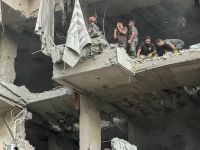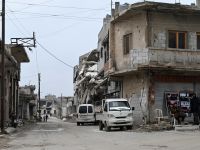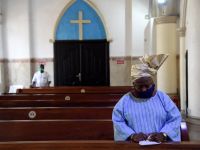As a group of tourists, foreign NGO workers and a smattering of Lebanese gather next to the St. George Hotel on Beirut’s waterfront, tour leader Marc Ghazali prepares his audience for the journey ahead of them. “I’m sorry to disappoint you, but this is not a tour about the Civil War,” he tells the crowd beside the historic hotel, now most notable for the giant “Stop Solidere” banner hung on its side.
Ghazali has been leading tours of Downtown Beirut, covering the history of the area’s postwar reconstruction, every Saturday for the past year and a half, beginning when he was still a political studies student at the American University of Beirut.
The reconstruction of Downtown Beirut by Solidere, a private company created to carry out the rebuilding and linked to the late Prime Minister Rafik Hariri, was a controversial topic.
And the tour’s title, “Layers of a Ghost City,” hints at Ghazali’s feelings about the process that rebuilt the once-vibrant urban center as a “ghost city” populated largely by empty condominiums alongside high-end restaurants and shops inaccessible to large swaths of the population.
But Ghazali says he tries to present an objective picture in his tours. At the start, he gives his audience a caveat: “I have my personal bias, but I promise not to hide information.”
Pointing to the St. George Hotel, whose owner is locked in a legal dispute with Solidere over the land where the posh waterfront strip of Zaitunay Bay now sits, Ghazali gives a skeptical account both of Zaitunay Bay’s construction and of the opponents who have embraced St. George as a symbol of resistance to the privatization of Downtown.
“Basically, the St. George Bay was the Zaitunay Bay of the ’60s and ’70s,” he tells his audience.
“You should know this is simply a fight between private interests. I’m trying to deconstruct the cliches of both sides.”
The idea of organizing a Beirut walking tour first came to Ghazali during a trip to Germany, where he took part in a walking tour along the Berlin Wall. Initially, he says, he thought to do a tour of the Green Line in Beirut, but changed his plan after realizing the difficulty of acquiring the necessary permission.
The subject of Downtown also spoke to him more on a personal level, Ghazali says. At 21, he is too young to have experienced the Civil War, but he witnessed the reconstruction of Downtown as a child.
“It was a huge construction site. You had this green fabric on all of the buildings and then suddenly you had these fascinating fascinating to a young kid buildings, and I did not understand how this happened,” he says. “I felt that [the site] had always been hidden, and then I realized that it did not exist before.”
After about nine months of research and obtaining the necessary permits, he began the tour in February 2017.
Initially, Ghazali says, he had envisioned the tour as targeting a Lebanese audience interested in learning more in depth about the city’s history, but it turned out that the bulk of the tour’s audience is foreign.
It is conducted in English, Ghazali says, because he feels less need to censor himself than he would in Arabic. As a result of the largely international audience, he has reshaped some aspects, including adding the caveat at the beginning that the tour is not about the Civil War.
“I started seeing a lot of the traps that people fall into in Lebanon. ... All the questions people asked were about the Civil War, Muslim versus Christian,” he says. “There’re plenty of other interesting things to talk about. I’m going to talk about the war only to serve the purpose of [talking about] reconstruction.”
A number of other walking tours exist in Beirut. One of the best-known is the tour led by Ronnie Chatah, which started up again this year after a four-year hiatus.
The reason for the break: His father Mohammad Chatah, a former finance minister and diplomat, was assassinated by a car bomb in 2013. No group claimed responsibility for the attack, but Chatah’s allies in the March 14 coalition believed his killing was linked to the assassination of other prominent opponents of the Syrian regime in Lebanon, including Hariri.
A monument to Chatah now stands on a quiet public square Downtown, and is one of the stops on Ghazali’s tour. A recent participant noted the irony that it appears to require an event as dramatic as an assassination to get an area set aside as a public space in Beirut.
Ghazali says that since he began the tour, he has come to see the postwar redevelopment of Downtown as just the latest in a series of iterations of the city. The French mandate-era construction of Nijmeh Square, he points out, was the result of demolishing the previous Ottoman-era buildings.
“I can put myself in the shoes of people after the French mandate started and ... I can imagine how angry they must have felt at this newly imposed building,” he says.
Now, those French-constructed buildings are regarded as part of the city’s cultural heritage. Ghazali says he believes one day, the same will be true of Downtown’s current iteration, and one day, it will begin to function as a true city center again.
“Probably this area is going to become a popular area again at some point,” he says.
But, he adds, “not in my lifetime.”
This article has been adapted from its original source.








